

 The Accurate Reloading Forums
The Accurate Reloading Forums  THE ACCURATE RELOADING.COM FORUMS
THE ACCURATE RELOADING.COM FORUMS  Guns, Politics, Gunsmithing & Reloading
Guns, Politics, Gunsmithing & Reloading  Reloading
Reloading  Lee collet neck die problem - dent between neck and shoulder
Lee collet neck die problem - dent between neck and shoulderGo  | New  | Find  | Notify  | Tools  | Reply  |  |
| one of us |
Hi, I like Lee collet neck dies and I have 1 for the 300WM and 1 for the 270W, that I use with no problem. I've recently bought a set for the 308W, but, when I size the neck, I can notice a small dent, right on the angle between neck and shoulder. The sized brass doesn't chamber very well, since I must apply some (little) force to close the bolt. The rifle seems to have a good chamber, since I can full lenght size the brass very easily. Did anyone has a similar problem? | ||
|
| One of Us |
So there you have it! One out of three Lee collet dies is defective. | |||
|
| one of us |
I wouldn't be surprised at all, it's a Lee die after all... | |||
|
One of Us |
Hey wildboar It sounds like your collets are contacting the shoulder area a little. You could try getting an appropriate size washer that would fit over the 308 case and put it around the case on top of the shell holder.  This will move the point at which the neck sizer stops sizing up toward the case mouth and away from the shoulder. I do this sometimes to see if leaving part of the neck fire formed size will increase accuracy. Have been unable to document anything yet but it definitely doesn't hurt. ____________________________________ There are those who would misteach us that to stick in a rut is consistency - and a virtue, and that to climb out of the rut is inconsistency - and a vice. - Mark Twain | Chinese Proverb: When someone shares something of value with you and you benefit from it, you have a moral obligation to share it with others. ___________________________________ | |||
|
| one of us |
Woods, you are probably right, I've had the very same idea; I'll try to make a couple of thin shims. | |||
|
| One of Us |
Be sure the collet is not stuck. | |||
|
| one of us |
No, it isn't... | |||
|
| one of us |
Woods is correct. Especially as the collet gets used alot it will bell out a bit at the bottom and require the washer. It's a bit of a hokey fix but it does work and once you do a few brass with the washer trick it still goes fairly fast. I wish they would use better materials and tolerances but I guess we get what we paid for. | |||
|
| one of us |
Thanks Woods and Kraky, a | |||
|
| one of us |
I would still contact Lee and have them send you a new die. | |||
|
| one of us |
Steve, it's not so easy for us in Europe, moreover with that die I will probably size 30 cases, 4-5 times per year.... | |||
|
| one of us |
Hey Woods, Nice flick. If a person had one of those Redding Multi-Height Shell Holder Sets, would it do the same thing without having to put the Washer over each Case? Would they be "High" enough? | |||
|
| one of us |
I tried the redding shellholders......010" isn't enough....or at least not for my dies. I think the washer I wound up using was about .090. I've had brand new lee collet dies that did something small to the base of the neck that the case became hard to chamber...the washer is a fix but kind of hokey. I liked Woods Idea of leaving the base of the neck unsized to "hopefully" center the case and make for better accuracy. For me it didn't help.....of course it didn't hurt either. I do admit Woods idea that the collet die with a body die is sweet.....I've got a few calibers set up that way.....AND SWEET IT IS! | |||
|
| one of us |
Yep, folks often overlook the thickness of the lip of the shellholder when setting up their dies. With a conventional FL die, if the lip is thicker than the die is designed for, then it will not size the case fully back to SAAMI standards. If the lips are too thin, then bumping the shellholder against the die will result in excessive headspace. Similarly, with Lee Collet dies the shellholder must be a reasonable match for the lip thickness the die was designed for. The washer fix is a simple one if the shellholder is too thin. As discussed in other threads, a Collet die in a shorter caliber, say, .308, can be used for a longer, similar caliber like .30-06 if the right thickness of washers are used on top of the shellholder. I resize .222 Magnums with a .223 Collet die in this manner, and it is very effective. Yes, the Lee products are made very economically and not to the finest quality control, but their price and engineering typically make them a bargain. Consider each collet die a "kit" that you clean, hone, and self-finish. If it breaks throw it away and buy a new one and you're still money ahead compared to many other brands. | |||
|
One of Us |
Hey H C kraky and stonecreek are right that the shellholders would probably not be enough of a fix. But what puzzles me is the complete role reversal here!! Normally you are the baling wire and bubble gum guy and I am the one promoting spending money on new "thingies". Is it possible that you are entering the new age ____________________________________ There are those who would misteach us that to stick in a rut is consistency - and a virtue, and that to climb out of the rut is inconsistency - and a vice. - Mark Twain | Chinese Proverb: When someone shares something of value with you and you benefit from it, you have a moral obligation to share it with others. ___________________________________ | |||
|
| one of us |
It's not the "height" of the shellholder, but the difference between the base of the case and the bottom of the die. The washers on top of the shellholder in effect make its lip (rim, upper face) thicker, thus increasing the distance between the base of the cartridge case and the die, or put another way, not allowing the case to be inserted into the die as far. | |||
|
| one of us |
Hey Woods, You might be counting your Role Reversal a bit early. Kraky got the dimensions that I was wondering about. Now we get to part Deux of the question: If the Washer works, why haven't you "Slotted the side of it" and Permanently Afixed(Bailing Wire, Bubble Gum, Duct Tape, 2-part Epoxy, Jet Glue, etc) it to the top of the Shell Holder? Or if possible, Jet Glue(great stuff) the Washer to the proper place on the extended portion of the Lee Die and you would probably not have to Cut the Slot? That business of dropping the Washer over the Case after it is in the Press and then removing it, looks like it would eventually get a bit annoying. Don't take this as being critical of your Fix at all. It seems to do the job well. Just wondering why you've not taken the "Fix" to the next level - making it permanent. ---- Actually have a part 3 question too. Are you all using "Lee" Shell Holders with those Collet Dies? If so, it looks like Lee would like to get his hands on the Collet Die, see what is Dimensionally wrong and implement some Corrective Action on the Future Die Sets. That way you all might not have to deal with the Washer at all once he gets everything corrected. Or perhaps I'm missing something? ----- Always good to see folks Engineering their way out of a problem | |||
|
One of Us |
Well you see I'm not really trying to fix a problem. I can neck size with all my Lee Collets without the problem wildboar was posting about. The only reason I try it is to see if it makes any difference in accuracy. Forster has a bushing bump sizing die that does the same thing  so somebody must think it's a good idea. So I only use the washer occasionally. ____________________________________ There are those who would misteach us that to stick in a rut is consistency - and a virtue, and that to climb out of the rut is inconsistency - and a vice. - Mark Twain | Chinese Proverb: When someone shares something of value with you and you benefit from it, you have a moral obligation to share it with others. ___________________________________ | |||
|
| one of us |
Actually up here in Wisconsin we look for fun things to do. The washer thing is like going to the county fair and playing the ring toss game. Every time you loop it over that unsized shell and make a perfect resize it's like winning a prize. You wouldn't want to take our fun away would you Hot Core!!!!!! Ha Ha...my Monday night humor. | |||
|
| one of us |
Since I have 2 identical Lee shell holders for the 308W/30-06/270W, I will very likely cut the washer and carefully glue it on the top of the shell holder. This forum is an invaluable source of good ideas. | |||
|
| one of us |
Hey Kraky, Fun is in a short enough supply that I'm sure not interested in reducing it by any amount. I do remember the old Ring Toss game. ----- Hey Wildboar, I DO NOT have any of those Collet Dies, so don't be mislead by any of my ramblings on this. I've no first-hand experience Glueing the washer to either the Shell Holder or the Portion of the Die that really needs to be Longer. This is all speculation on my part. Since I don't have one, it seems that Glueing the Washer to the actual portion of the Die that is supposed to make contact with the Shell Holder would be the best place for it. That way (guessing) there would be no reason to "Slot" the Washer. If for some reason that is impractical to do, then Slotting one, while making sure it remains "Flat" and Glueing it to the Shell Holder seems to be an option. You can Raise the Press so the Die contacts the Washer to hold it against the Shell Holder while the Glue is Setting. By the way, if you do try the Jet Glue(from a Remote Control Airplane Shop), it Sets IMMEDIATELY. There is no repositioning, Where it initially touches is where it remains. ----- But, then you loose the Fun of the Ring Toss. Best of luck to you. | |||
|
| one of us |
I ran out several washers on my old lathe to fit fairly closely and the OD is only as large as the bottom of the die. In this way you can hold the washer between your thumb and index finger and slide it over the shell casing (standing upright in a reloading tray). Rolling the fingers slightly will grip the case and the washer never leaves the fingers. When I remove the sized case from the press, I am able to hold on to the washer and case both, and drop the case out of the washer, and repeat the process again. With the right size washer (OD) and very little practice, you don't lose any time at all. Certainly not as much fun as Kraky's method, but I am on strict orders not to get too excited. Jim Please be an ethical PD hunter, always practice shoot and release!! Praying for all the brave souls standing in harms way. | |||
|
| One of Us |
There really should be a separate forum for those who use Lee equipment. | |||
|
| one of us |
Especially those suggested by Winchester 69. | |||
|
| One of Us |
maybe the die needs to be adjusted? In my humble opinion, and not having a lee die of this sort- glueing to the shell holder would throw the other dies, off. The die ought to work as designed. At the very most, I would slot the washer so I could slid on and off the shell without dropping it over the neck, but not interferring with the other dies. Judge Sharpe Is it safe to let for a 58 year old man run around in the woods unsupervised with a high powered rifle? | |||
|
| one of us |
Hey Woods, Toss in a Flick of this Collet Die so I can at least see what it looks like. | |||
|
One of Us |
Okay H C, now pay close attention! This is a 22-250 Lee Collet. Notice the depriming rod which is actually a straight mandrel, when the die is installed in the press you can reach up under the die and move this around 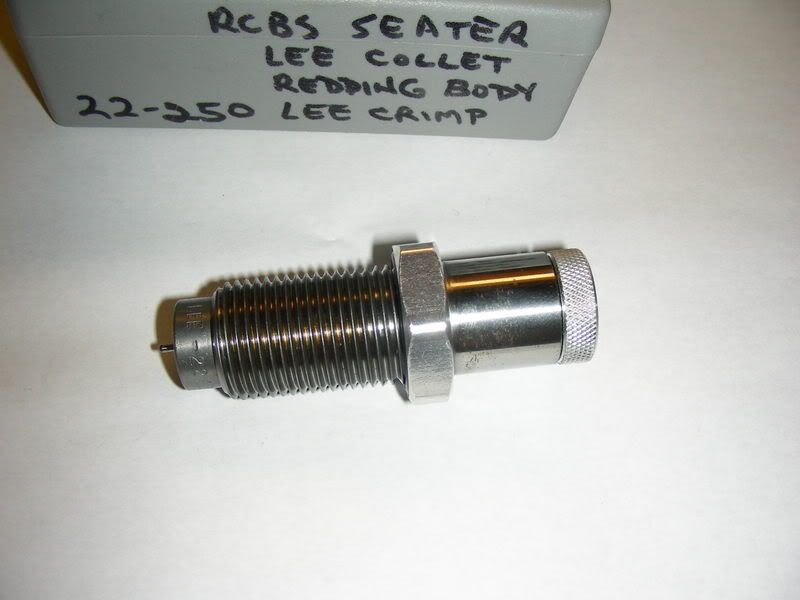 Here is the die disassembleed into the die body, the cap and the mandrel. You can actually take if further apart but it takes some force to get the internal collets and collet forcing cone out 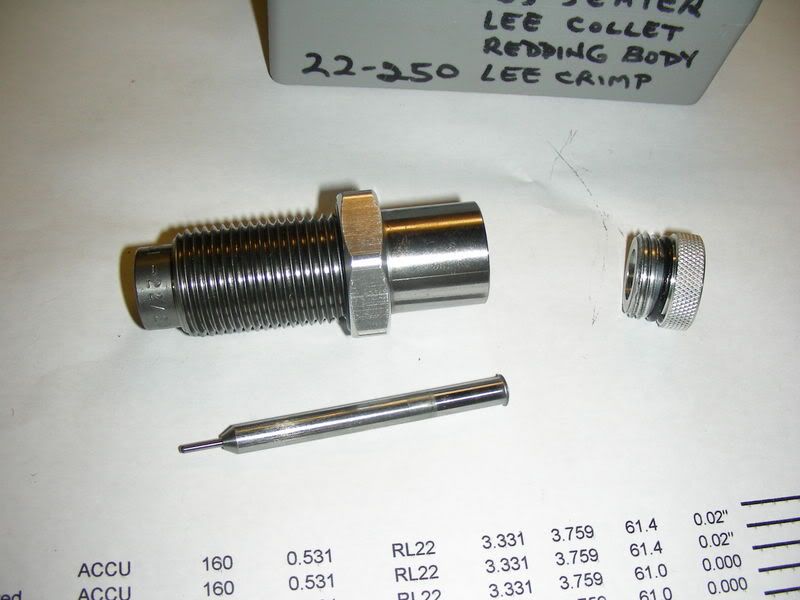 This is looking inside the die body to the collets and forcing cone 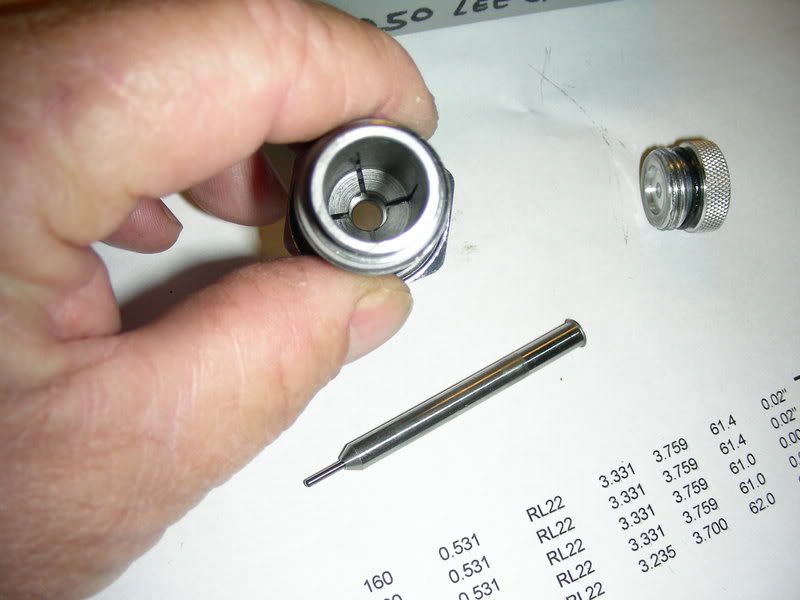 A top view of the die with the cap removed and the mandrel pushed up a little 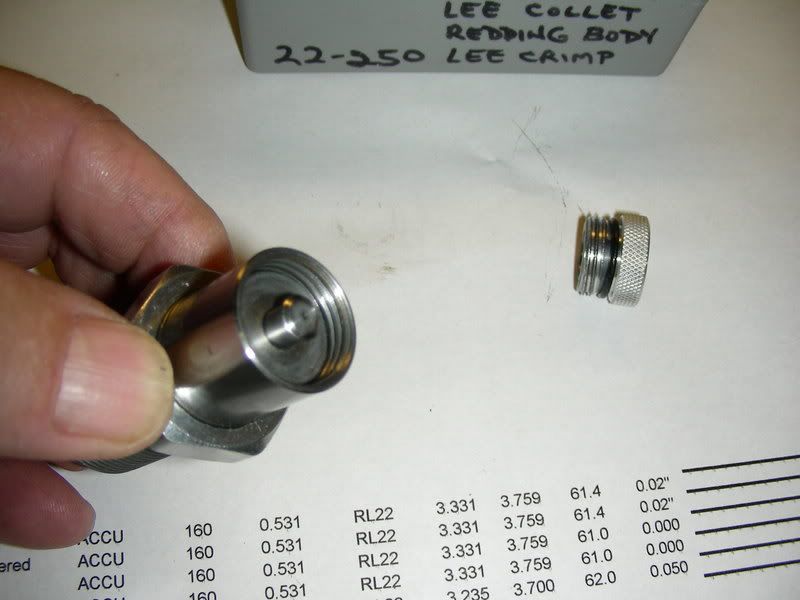 Really a simple instrument. The instructions say to not let the press toggle over and just put weight on the handle (about 25 pounds). Some do it differently and are successful and some do it differently and have problems. I adjust the lock nut up to the top of the threads as you can notice in the first "flick". This puts the handle in the most horizontal position and gives the most control for me. I have sent off and received for $5.00 ea different size mandrels, like for my .284 caliber mandrel which is normally .282" I sent off for some at .281" and .280" to try and get more bullet grip and see if it makes a difference. 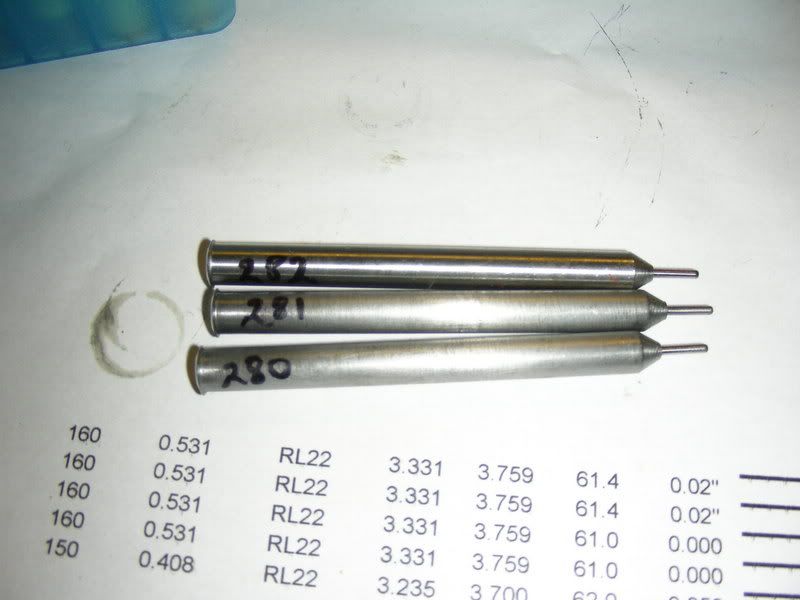 Haven't had time to try it yet. ____________________________________ There are those who would misteach us that to stick in a rut is consistency - and a virtue, and that to climb out of the rut is inconsistency - and a vice. - Mark Twain | Chinese Proverb: When someone shares something of value with you and you benefit from it, you have a moral obligation to share it with others. ___________________________________ | |||
|
| One of Us |
Wildboar, Have you checked the runout of the cases sized with this die? I see the problem as one that, besides delaying the functioning of the collet, causes the clamping force to be applied to the case neck asymetrically. Some deviation, probably a canting, in the machining centerline of the collet taper has caused the symptoms experienced. Check your neck runout; this die probably needs to be replaced. It has been fun, though! | |||
|
| One of Us |
Hi Wildboar, in this forum you can find a lot of good ideas, but can also contact Lee or the import dealer in Italy, probably they can help you. Overthere Lee dies are much cheaper than Redding dies and probably have not the same quality but I'm shoure you can work out your problem with an accurate analize of the misure from your dies. Faina I prefer to die standing that to live in knee | |||
|
| one of us |
Hey Woods, Thanks for the flicks, that helps a lot. So if the Washer was Jet Glued to the Extended "Sleeve" portion (that moves up to force the Collet Fingers to close) then it would prevent the Die from being completely taken apart. What happens if you leave the Decapping Mandrel out of the Die and Resize a Case? If you leave the Decap/Mandrel out, is it then possible to adjust the amount of Neck Compression by varying the Height of the Die Body in the Press? Do you believe the folks at Lee made the Sleeve a bit short to keep folks from damaging the Collet Fingers due to over compression? ----- It is a very interesting Compression Design and simple as you mentioned. I worked with a real Genius when I was going to school. He had mentioned that anytime a person is able to make a Design so simple that when anyone looks at it they think, "I could have thought of that!", then it is a brilliant design. | |||
|
| one of us |
If the washer was larger OD than the OD of the tube, yes. The whole works comes out the top.
The fingers will close on the neck and reduce the neck size more than is required.
I suppose you could, but I don't know why anyone would want to. You wouldn't be squeezing the neck around the straight mandrel for one. And it takes very little time to polish the mandrel in a drill to get the bullet grip that is desired. Mandrels can be made very easily also. I did it so I know it can be done easily.
If this is a question as to what may be the root cause of Wildboars problem..........the first thing I would "look" at would be the height of his shell holder. Not the overall height, but the height from where the case heads rests to the top of the shell holder that contacts the bottom of the die. If this is reduced for what ever reason, it could cause his problem. Edit: I don't think there is anything wrong with the dies he has. Getting a replacement (die) from Lee may not fix the problem. I would think Lee has to manufacture the dies to work with the most common shell holders, or maybe just theirs???? If I use a shell holder that is not the right size, it is not the fault of Lee is it?? Jim Please be an ethical PD hunter, always practice shoot and release!! Praying for all the brave souls standing in harms way. | |||
|
| one of us |
I don't think so; I'm using a Lee shell holder. The problem is caused by a defective die IMO; the QC at Lee factory is not quite satisfatory as I could experience with some other stuff, but their product design is sometimes remarkable. | |||
|
| one of us |
OK. Well, I was certainly mistaken. Lee should go good for it. Jim Please be an ethical PD hunter, always practice shoot and release!! Praying for all the brave souls standing in harms way. | |||
|
| one of us |
SMALLER MANDRELS: If a mandrel is not giving me sufficient neck tension, then I chuck it in a drill press and polish it down by a thousandth or two with emery cloth (finish with steel wool). DON'T OVERDO it, however, as it takes surprisingly little work. TOGGLE OVER: Setting the die so that the press handle actually DOES toggle over is the best way to control pressure and make it consistent. You don't want to set it so that it takes jumping up and down on the handle to toggle over, just around 15-25 lbs, depending on the handle and leverage of your press. Lee's advice against toggling over is trying to prevent you from placing excessive pressure on the collet base, which WILL deform if squeezed too hard. CLEAN BETWEEN THE PETALS: There can be metal shavings or other foreign matter in the cuts between the collet petals when you receive a new die. Always disassemble and clean out the four petal cuts to assure that the collet can fully compress. LUBE THE "FUNNEL": The top inside portion of the assembly is a tapered funnel that mates with and squeezes the collet together as the collet is pushed upward into it by the shellholder. This tapered area needs to be smooth, clean, and very slightly lubricated. Wipe it out when new, and very lightly lubricate. ROTATE 45 DEGREES (optional): If you want the optimum in neck concentricity and just a tad more neck tension (without using a smaller diameter mandrel), you can rotate the case 45 degrees in the shellholder (after sizing the first time) and size it again. This will place the petals of the mandrel directly over where the spaces were on the first sizing, which theoretically evens things out a bit and make the neck tension just a little greater. Doing this is simple, if desired, and becomes second nature. Compared to lubricating and degreasing lubricated cases, it is still much faster and cleaner than using conventional dies. BOTTOM LINE: For any cartride/action that does not require more than neck sizing, the Collet die is a gift from heaven. It also produces some of the "straightest" assembled ammunition you can make. Avoiding the mess of lubricating, and more importantly, removing the lubrication from cases, speeds the process tremendously. The little quirks caused by Lee's very economical (read: cheap) manufacturing methods and materials are easy enough to deal with. Someone could build a Collet-type die that would be a precision instrument and last a life time. But it would cost five times what the Lee product does. So if a Lee gives up on me, I just toss it and buy a new one and am still big dollars ahead. I'm attempting to acquire a Collet die for every caliber I have, and have even modified some collet dies to load calibers that Lee doesn't even make a die for. But that's a subject for a different thread. | |||
|
| Powered by Social Strata |
| Please Wait. Your request is being processed... |
|
 The Accurate Reloading Forums
The Accurate Reloading Forums  THE ACCURATE RELOADING.COM FORUMS
THE ACCURATE RELOADING.COM FORUMS  Guns, Politics, Gunsmithing & Reloading
Guns, Politics, Gunsmithing & Reloading  Reloading
Reloading  Lee collet neck die problem - dent between neck and shoulder
Lee collet neck die problem - dent between neck and shoulder

Visit our on-line store for AR Memorabilia

